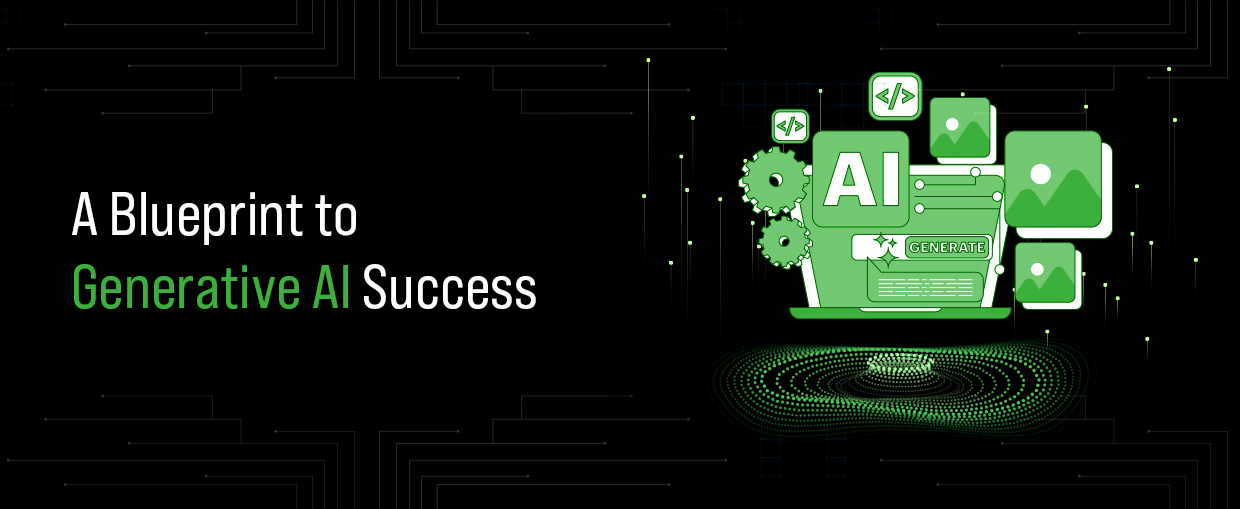Generative AI development is reshaping the technological landscape, pointing to a future where AI-generated content becomes commonplace. The global generative AI market, valued at USD 25.86 billion in 2024, is projected to reach USD 803.90 billion by 2033, growing at a CAGR of 46.5% from 2024 to 2033. The rapid expansion of the generative AI market reflects the growing dependence on AI for generating innovative content and solutions. This surge in demand is fueled by its diverse applications, including super-resolution, text-to-image, and text-to-video conversions. Additionally, the ongoing modernization of workflows across industries like media, retail, manufacturing, IT, and telecom is further driving the adoption of generative AI.
In this blog post, we’ll explore key insights and best practices for generative AI development. By the end of this guide, you’ll have a solid understanding of what generative AI is, how it works, its benefits, the essential tech stacks, and the key steps and challenges involved in developing generative AI solutions. Let’s get started!
Understanding Generative AI
Generative AI is a form of artificial intelligence designed to create content such as images, text, or music. Popular tools like ChatGPT, Bing, Bard, YouChat, DALL-E, and Jasper are all powered by generative AI. These systems learn from vast datasets and generate new, original content that resembles the input data. Today, generative AI is applied across various industries, including entertainment, healthcare, and finance.
While it has made significant strides, it’s essential to use this technology responsibly to prevent the creation of misleading or deceptive content.
How Does Generative AI Function?
Generative AI analyzes patterns and relationships in existing data using algorithms. Text, images, or music can all be included in this data. After learning these patterns, the model may use them to produce new data that resembles the training set. There are two ways in which generative AI models can generate new data:
Generative Adversarial Networks (GANs): A discriminator and a generator are the two competing neural networks that makeup GANs. The generator produces new data, while the discriminator distinguishes between real and generated data. This competition drives the generator to improve its ability to produce realistic content.
Variational Autoencoders (VAEs): VAEs are neural networks that encode input data into a compressed representation(latent space) and then decode it to create similar data.
The competitive method of GANs or the encoding and decoding of VAEs, in short, allows generative AI models to learn from existing data to produce new data.
Key Insights for Developers on Generative AI
Here are the key things that every developer should know about generative AI:
Knowing the Basics – Generative AI trains models to produce new content, like images, music, text, or video, based on a given dataset. It uses a generator to create content and a discriminator to differentiate between real and generated data.
Training Process – Generative AI uses a two-step process. The generator creates content from random input. The discriminator evaluates and provides feedback to refine the content. This loop continues until the generator produces realistic results.
Data Needs – Generative AI models need large, diverse datasets for training. The quality and diversity of this data directly affect the generated content’s quality. Developers must ensure the dataset aligns with the desired content.
Architecture Choice – Generative AI offers several architectures, including DCGANs, VAEs, and transformer models. Each has its advantages and limitations, depending on the specific application and data being used.
Evaluation Metrics – Measuring the quality of generated content can be difficult, as traditional metrics like accuracy or loss aren’t always effective. For image generation, metrics such as Fréchet Inception Distance (FID) and Inception Score (IS) are commonly used.
Key Benefits of Generative AI
Generative AI provides a wide range of benefits, making it an invaluable tool across various industries:
Automated Content Generation
Generative AI revolutionizes content production by automating the creation of personalized and creative materials at scale. This reduces the need for human input, cuts costs, and boosts productivity, making content creation faster and more efficient.
Better Customer Experiences
Utilizing generative AI helps businesses provide personalized and unique consumer experiences. By offering personalized product recommendations and user interfaces generative models can increase consumer involvement and satisfaction.
Reduced Costs & Time Efficiency
Generative AI cuts cost and time by automating content creation, enabling businesses to quickly generate marketing materials, product descriptions, and designs at a lower cost while speeding up production and reducing the need for large teams.
Automation
Generative AI automates repetitive tasks like data entry, image/video editing, and report generation, allowing human resources to focus on more strategic and complex activities.
Data Analysis
Generative AI analyzes large datasets to uncover insights, helping businesses understand customer behavior, market trends, and opportunities, leading to more informed decisions and better strategies.
Personalization
Generative AI enables businesses to offer personalized experiences by tailoring recommendations, ads, and product variations, boosting customer satisfaction, engagement, and conversions.
Customization
Generative AI allows businesses to customize products and services, creating personalized designs and user experiences tailored to individual customer needs.
Essential Tech Stacks for Generative AI Development
Generative AI development relies on a range of frameworks, libraries, and tools. Here’s a typical tech stack used for building generative AI solutions:
Popular frameworks for creating and training generative AI models include TensorFlow, PyTorch, and Keras. They offer a variety of model architectures, optimization algorithms, and high-level APIs. Generative model architectures include transformers, generative adversarial networks (GANs), and variational autoencoders (VAEs). Successful implementation requires a thorough understanding of these structures. Using pre-trained models like GPT-3 or StyleGAN2 can significantly streamline generative AI projects by reducing development time and resource demands.
Effective data preprocessing, utilizing libraries like NumPy and Pandas, is essential for preparing clean, well-structured datasets. Rotation and noise addition are examples of data augmentation techniques that help increase the diversity of training data. It frequently takes a lot of computational power to train generative AI models. GPUs speed up the training and inference procedures when they are supported by libraries like CUDA and cuDNN.
While this tech stack forms a strong foundation for generative AI development, the choice of tools and libraries can vary based on project needs and team preferences.
Developing Generative AI Solutions: A Step-By-Step Process
Developing a generative AI solution involves a series of structured steps. Here’s an overview:
1. Identify the Problem
Clearly state the issue that you wish to resolve with generative AI, along with the type of material that will be produced, its intended use, and its desired characteristics.
2. Collect and Preprocess Data
A balanced, varied dataset that reflects the content you wish to produce should be gathered or created. The data should be preprocessed and formatted appropriately for training.
3. Select a Generative Model Architecture
Depending on your issue and the characteristics of your data, choose a suitable generative model architecture, such as transformers, GANs, or VAEs.
4. Implement the Generative Model
Implement the selected generative model architecture using a deep learning framework and customize it to suit your specific needs.
5. Train the Model
Use the prepared dataset to train the generative model. Experiment with regularization methods and optimize hyperparameters.
6. Evaluate and Refine
Use the proper metrics to assess the model’s performance. If necessary, adjust the model to enhance the output quality.
7. Deploy and Integrate
Integrate it with other components of your solution and deploy the generative model in a production setting.
8. Continuously Improve and Iterate
Track and assess the model’s performance, get user input, and refine the solution to overcome constraints and foster innovation.
9. Address Ethical Concerns
Actively work to minimize biases, promote fairness, and establish robust safeguards to prevent the misuse of generative AI technology.
10. Ongoing Maintenance and Updates
Regularly update and refine the solution, keeping pace with the latest research and technological advancements to ensure optimal performance.
Challenges in Generative AI Development
Generative AI development presents several challenges, especially in maintaining the consistency and quality of generated content. Models may sometimes produce unrealistic or incoherent outputs, and the quality of training data plays a crucial role in shaping the results. Limited or biased datasets can lead to inaccurate or biased content generation. Additionally, training generative models is resource-intensive, requiring high-performance hardware like GPUs or TPUs and significant time, particularly for large-scale tasks.
Another major hurdle is the difficulty in evaluating generative models. Traditional metrics designed for discriminative models often fall short in assessing generative performance, and there is ongoing research to establish effective evaluation benchmarks. Furthermore, generative AI raises significant ethical concerns, including the creation of deepfakes, fake news, and harmful content. These issues underline the importance of generative AI ethics and the need for responsible AI development.
Addressing these challenges in AI development demands continuous research, collaboration, and the establishment of best practices to ensure that generative AI is used both responsibly and ethically.
Closing Thoughts
Generative AI is transforming industries worldwide, driving innovation in content creation and problem-solving. To fully harness its potential, businesses must navigate the complexities and challenges of its implementation. By collaborating with a top-tier AI development company that provides expert artificial intelligence development services and prioritizes ethical AI practices, businesses can maximize the benefits of generative AI while ensuring responsible use. Reach out to us with any questions or inquiries, and we’ll help you unlock the full potential of generative AI technology!



